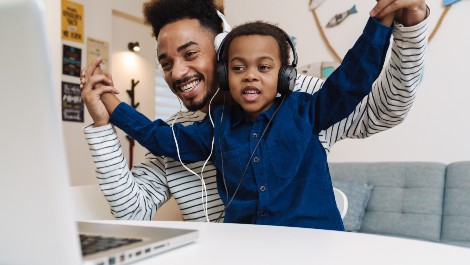My Ultimate Coping Playlist (for Parents and Educators)
 We go through positive and negative emotions daily. It is ok to experience different feelings, but we must also find positive ways to cope. Learning to manage our emotions begins when we are young and continues throughout our lives. Experts agree that you can build children’s resilience and set them up for success by learning and then teaching them healthy coping strategies.
We go through positive and negative emotions daily. It is ok to experience different feelings, but we must also find positive ways to cope. Learning to manage our emotions begins when we are young and continues throughout our lives. Experts agree that you can build children’s resilience and set them up for success by learning and then teaching them healthy coping strategies.
Why do Parents and Educators Need to Take Care of Themselves?
The energy invested in self-care can have positive results. The question is: how are you taking care of yourself? Parents, families, teachers, providers and other caregivers often prioritize their children’s or student’s needs over their own.
Remember: taking care of yourself is vitally important in caring for others, especially when caring for children.
“Parents often put their children’s needs before their own, but doing so continuously and without fail does children a disservice,” Allison Gilbert, senior writer for the Center for Parent and Teen Communication, said in an article. “In fact, parents who practice taking care of themselves demonstrate there are healthy ways to manage life’s bumps and bruises. Perhaps above all, we create powerful teachable moments when we expose our children to positive stress management techniques like self-care.”
Why is Self-Care Important to Teachers and Providers?
The word “care” is in the job description for teachers and providers. However, taking time for self-care can often seem like an additional task. Again, taking care of yourself is vitally important in taking care of your students. Finding effective and simple ways to practice self-care produces different results, including becoming a more effective teacher, managing stress effectively and serving as an example for your families.
“Self-care isn’t just good for the educator, but also the students. Understanding that link between self-care and professional effectiveness can really help people understand it’s not selfish,” Jacqueline Zeller, an education lecturer for the University of Virginia, told Harvard EdCast. “It helps educators think more objectively about situations and keep more professional boundaries. It helps us set good examples for our students.”
What are Simple Ways to Cope and Practice Self-Care?
From “Don’t Stop Believin'” by Journey to “Happy” by Pharrell Williams, music has always been a way to inspire hope and uplift our moods. Music makes us, well, feel happy. Through music, we find ways to connect during difficult times. Remember: we are all in this together. Use the “My Ultimate Coping Playlist” below in five ways:
- Create a “Positive Music Playlist.”
- Download “My Ultimate Coping Playlist.”
- Complete the categories on the document.
- Share with parents, families, friends and co-workers.
- Select songs from the playlist to manage stress.
What are Examples of Happy Songs?
- Don’t Worry, Be Happy by Bobby McFerrin
- Happy by Pharrell Williams
- Don’t Stop Believin’ by Journey
- Lovely Day by Bill Withers
- We are the World by USA for Africa
- I’m Still Standing by Elton John
- Dancing Queen by ABBA
- Walking on Sunshine by Katrina and the Waves
- All-Star by Smash Mouth
- I Gotta Feeling by Black Eyed Peas
- (I Got You) I Feel Good by James Brown
Share your happy songs and photo with @MDEngageEarly on Facebook, Twitter and Instagram. #MyHappySongs
MFE Presents: The Coping and Resilience Collection
Take a moment to review the MFE Coping and Resilience Collection where you will find coping skill activities and other helpful resources to support positive mental health conversations. Teachers/Providers: Share with parents and families. Visit this collection often as we add new resources every month. Below are just a few examples of the resources available to download and share:
- Identifying and Recognizing Emotions (activity sheet)
- Teaching Your Child to Identify and Express Emotions (tip sheet)
- Coping Skills (activity cards)
- Today I Feel (activity)
- Building Resilience in Children and Teens (available in English and Spanish)



